Sanyo ICC-82D
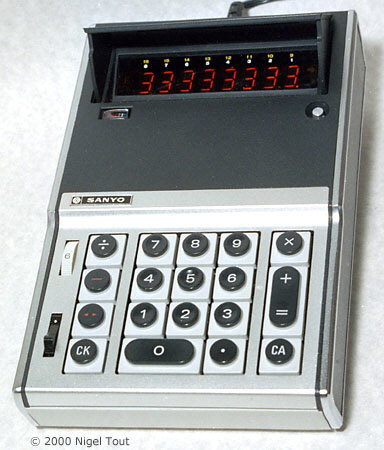
Sanyo ICC-82D
Distinctive features: One of the first hand-held, battery powered calculators.
Technical details:
Display is 8 digits amber gas-discharge tubes.
Four-function. Fixed decimal point.
Main integrated circuits - Sanyo LM8001J, LM8002F, LM8003H, LM8005B (here date coded week 16 & 17 of 1971).
6.6v & 7.3v sealed rechargeable battery.
133 mm x 210 mm x 50 mm (5.25" x 8.25" x 2").
Launched in Japan in May 1970[1], and the U.S.A. in September 1970 (see photograph below).
Made in Japan.
Has a battery-level meter (just below the display on the left) and a flip-up display cover/hood.
This model was also sold labelled for the Dictaphone company and sold as the Dictaphone 1680.
Significance: The Sanyo ICC-82D is hand-holdable, but definitely not a pocket calculator.
The state of development of electronics at this time required four large-scale integrated circuits (LSI) for the calculating functions.
Several early calculators were supplied with an expensive-looking hard fitted carrying case. This was appropriate at that time since these were very expensive instruments.
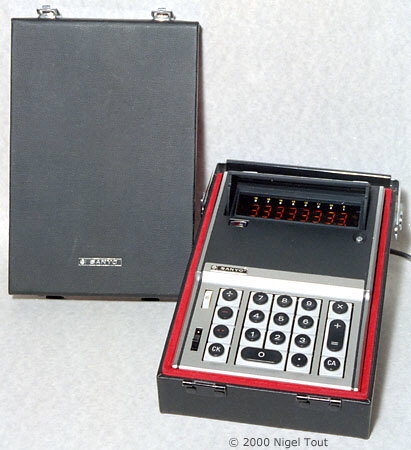
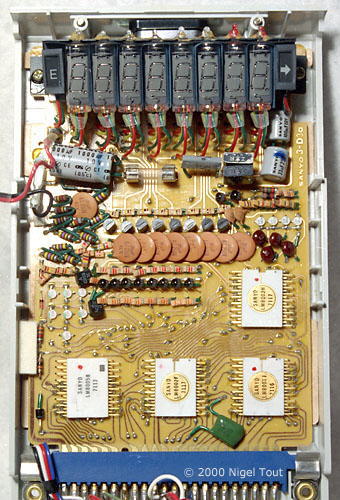
Sanyo ICC-82D in its plush-lined hard carrying case.
Pressing the button to the lower right of the display allows the display hood/cover to flip up and switches the calculator on.
Closing the hood also switches the calculator off.
On the left
below the display is the battery level meter.
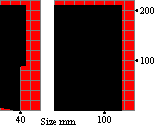
With the cover removed, revealing the gas-discharge display tubes and the circuit board with the four Sanyo integrated circuits.
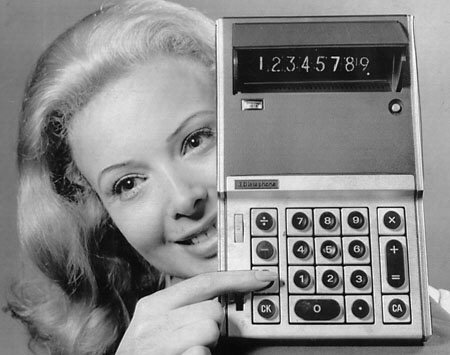
This is a photograph sent out when the Dictaphone version of the Sanyo ICC-82 was launched in the U.S.A. The caption says:
"ATTENTION BUSINESS EDITORS
9/8/70 [September 8th 1970] - New York: This 40-ounce calculator just introduced by Dictaphone is the smallest [calculator with a] visual display in the U.S. It is powered by self-contained rechargeable batteries, but can also operate on AC using its recharging cord. It's 8.5 by 5 inches, has 16-digit capacity, and adds, subtracts, multiplies and divides in milliseconds."
The electronics in the Sanyo ICC-82D was at the leading edge of technology at the time. The development of the electronics was reported in the electronics technical magazines:
In April 1969 Electronics reported that[2] "Sanyo Electric Co. is counting on an LSI miniature calculator with a built-in power pack in an effort to gain ground on Hayakawa [Sharp]. Sanyo says it will start sales this fall, just a few months after Hayakawa goes to market with its LSI - but line-powered - machine. The battery pack - four nickel-cadmium rechargeable "C" cells - can run the calculator for three hours before it needs a recharge. Power drain is a mere two watts - 1.2 watts for the two-phase logic circuits and 0.8 watts for the display and its drives, according to Sanyo. Sanyo's cordless machine has 13 different MOS arrays in its logic circuits, plus four transistors, eight resistors, and four capacitors in the clock circuits. The company stoutly insists it will produce the MOS packages itself; insiders in the semiconductor business, though, maintain the Sanyo has had trouble producing bipolar IC's at a reasonable cost and almost certainly will have to turn to U.S. suppliers for MOS arrays."
This article references a battery powered calculator that uses "13 different MOS arrays in its logic circuits". This appears to be for a model that did not actually come to market.
In a follow up in Sepetember 1969 about the electronic circuits Electronics reported[3] "Japan's Sanyo Electric Co. is seeking government approval of a licensing arrangement reached with General Instrument Corp. Under the arrangement, Sanyo will at first import and then manufacture the U.S. firm's metal, thick-oxide nitride silicon LSI circuits for use in the Japanese company's new miniature desk calculator. The calculator is expected to go on the market early next year. Terms of the 10-year licensing arrangement call for General Instrument to receive an $80,000 initial payment and a 3.25% royalty. Although Sanyo will be allowed to sell the LSI circuits separately, the company didn't win an exclusivity clause. Sanyo is investing $4.17 million in new production facilities to manufacture the circuits. Domestic production is expected to start in June; the company's initial goal is 70,000 circuits. The calculator itself has been redesigned so that each machine will require only four or five LSI circuits."
The development problems with the ICs appear to have delayed the introduction of the Sanyo hand-held calculator until about the same time that competitor calculators from Canon (Canon Pocketronic) and Sharp (Sharp QT-8B) appeared. Sanyo was then never quite at the forefront of calculator development. The miniature calculator emerged as the Sanyo IC-82 and the portable Sanyo 0081 "Mini Calculator", using integrated circuits marked with the "GI" logo of General Instruments Microelectronics of the U.S.A.
There is a YouTube video showing the troubleshooting, repair and use of a 'Dictaphone' labelled version of this calculator at www.youtube.com/watch?v=C-o6aznNuGo
References
- Advertisement in Nihon Keizai Shimbun 1970 April 30. On Dentaku Museum site at http://www.dentaku-museum.com/.
- "... as Sanyo tries to top Hayakawa with battery pack ...", Electronics, Apr. 14 1969, p219.
- "Japanese calculator gets U.S. circuitry", Electronics, Sep. 15 1969, p221.
Hand-held Calculators
Vintage Calculators
Text & photographs copyright, except where stated otherwise, © Nigel Tout 2000-2026.